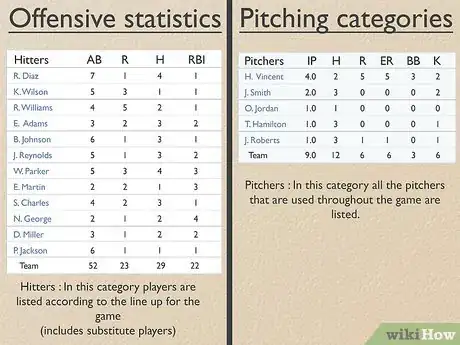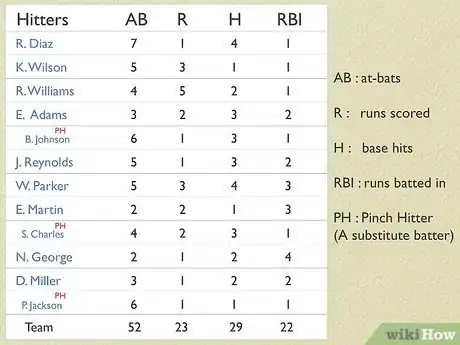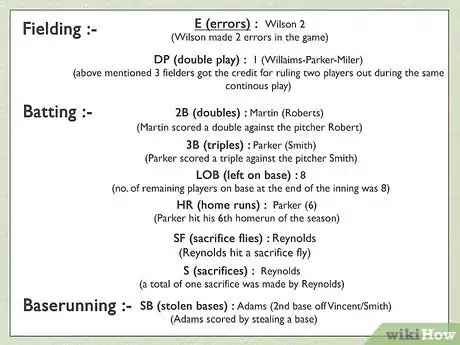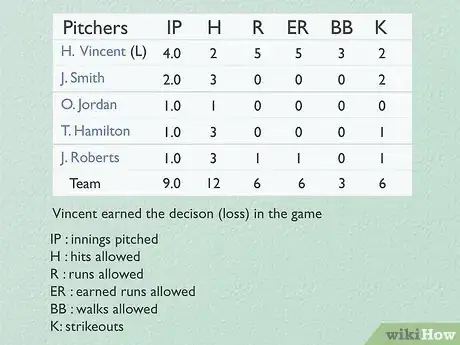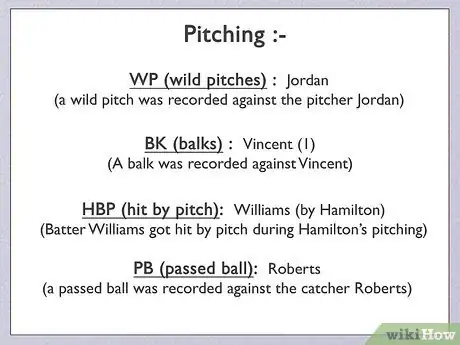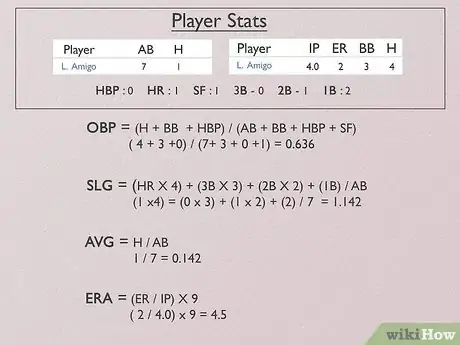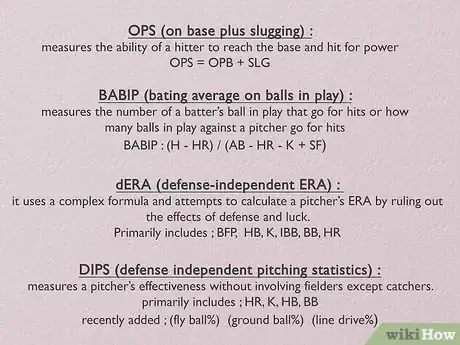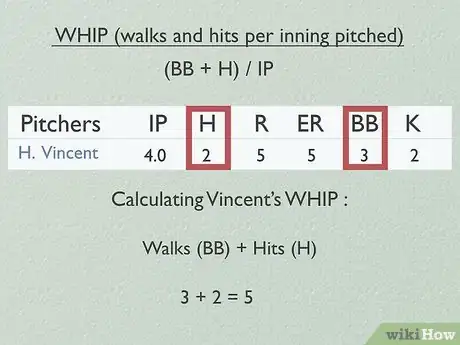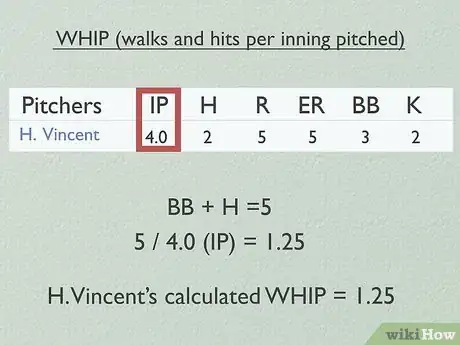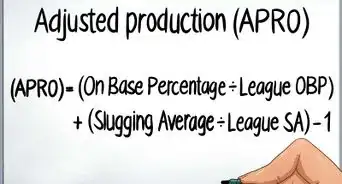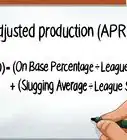This article was co-authored by wikiHow staff writer, Eric McClure. Eric McClure is an editing fellow at wikiHow where he has been editing, researching, and creating content since 2019. A former educator and poet, his work has appeared in Carcinogenic Poetry, Shot Glass Journal, Prairie Margins, and The Rusty Nail. His digital chapbook, The Internet, was also published in TL;DR Magazine. He was the winner of the Paul Carroll award for outstanding achievement in creative writing in 2014, and he was a featured reader at the Poetry Foundation’s Open Door Reading Series in 2015. Eric holds a BA in English from the University of Illinois at Chicago, and an MEd in secondary education from DePaul University.
There are 23 references cited in this article, which can be found at the bottom of the page.
This article has been viewed 162,145 times.
Learn more...
Baseball fans and analysts use statistics as the primary way to evaluate players. While conventional statistics still have a major influence, new methods of statistical analysis show great effectiveness in examining records and predicting player performance. By learning how to read baseball statistics, fans can grade players for fantasy leagues or simply expand their understanding and appreciation of the game.
Steps
Understanding Basic Statistics
-
1Scan a standard box score. Box scores are statistical representations of how players performed in specific games and you can find them in the Sports section of a newspaper or on a sports website. Standard box scores list, in a table format, 4 offensive statistics and 6 pitching categories.
-
2View the team's lineup. The entire lineup is listed in the offensive, or batting, section of the box score. Players are listed in batting order with the positions they played during the game following their names. Substitutes' names are indented in the box score and are listed under the player they replaced. The 4 categories listed in the offensive table are:Advertisement
-
3Scan the more-detailed fielding and batting information under the offensive table. Individual accomplishments are singled out in this section. For example, if a player named Smith hit his 6th home run of the season, the box score would read, HR: Smith (6). Other statistical categories in this section of the box score would include:
- E: errors, LOB: left on base (team statistic), and DP: double plays (team statistic).
- 2B: doubles, 3B: triples, and HR: home runs (with season total).
- SB: stolen bases, SF: sacrifice flies, and S: sacrifices.
Reading Pitching Statistics in a Box Score
-
1Browse pitching statistics. Pitchers are listed in the order they appeared in the game. If a pitcher earned a decision in the game--win, loss or save-�it is shown after his name as either W, L or S. The symbol is accompanied by his current win-loss record or the number of saves he has earned to date. The 6 categories listed in the pitching table are:
- IP: Innings pitched:[5] this can involve a decimal figure of either .1 or .2, representing part of an inning. For example, a starting pitcher completed 6 full innings and retired one batter in the 7th. His IP figure would be 6.1.
- H: hits allowed
- R: runs allowed
- ER:[6] earned runs allowed
- BB:[7] walks allowed
- K:[8] strikeouts
-
2
-
3Examine season statistics. Season statistics include all of the categories listed in box scores, and also other important data. Some of the most notable are:
- OBP:[13] To find a player's on-base percentage, or OBP, add his hits, walks and hit-by-pitch totals and divide that sum by the combined total of his at-bats, walks, hit-by-pitch and sacrifice flies.[14] (H+BB+HBP/AB+BB+HBP+SF)
- Slg.: To find a player's slugging percentage, divide his total bases by his at-bats. Total bases are the sum of the player's home runs x 4, triples x 3, doubles x 2, and singles.[15]
- Avg.: Divide the number of hits by the number of at-bats to compute Avg., which is the player's the batting average.[16]
- ERA: Earned-run average, or ERA represents a pitcher's overall effectiveness per 9 innings. To find an ERA, divide the pitcher's earned runs by his innings pitched, and multiply the quotient by 9.[17]
-
4Investigate other statistical applications. In recent decades, various methods of statistical analysis in baseball have surfaced. Few have revolutionized the process of evaluating baseball talent like Sabermetrics. While many of Sabermetrics' tenets have gained widespread acceptance among fans and analysts, the two below stand out.
- OPS: On Base + Slugging.[18] Sabermetrics creator Bill James sought a simple, defining statistic that would gauge a player's ability to produce runs. After compiling OPS figures on hundreds of players over many years, its effectiveness in determining a player's value to his team was continually supported. The Major League average for OPS is 0.728. A superstar has an OPS of 0.900.
- Pitching analysis: Using a variety of complex computations, Sabermetrics devised ground-breaking methods to examine pitchers. With nomenclatures as unusual as their formulas, BABIP, dERA and DIPS measure pitching effectiveness while removing the effects of luck and defense, and incorporating the effect of the ballpark.
Viewing WHIP - Walks and Hits per Inning Pitched[19]
This stat shows how many times in an inning a pitcher is allowed to reach base. A lot of statisticians believe it is a better formula to rate a pitchers performance than ERA.
-
1Add walks and hits given up by the pitcher in his outing.
-
2Divide the above total by the total number of innings pitched. For example:[20]
- Kershaw walks none and gives up one hit over 7 innings, 1/7 = 0.143 WHIP. If that hit was a home run, his ERA would be 1.28. But it if was just a hit, his ERA would be 0.00 which doesn't fully dictate what happened. To better show the difference, say he scatters 3 walks and 4 hits, but no runs. His ERA is still 0.00, but now his whip has jumped to 1.00. You can take that two ways, either he gets out of trouble, or he's gotten lucky to avoid giving up runs.
Community Q&A
-
QuestionIn pitchers stats, what does IBB stand for?
 DonaganTop AnswererIt stands for "intentional base on balls," or an intentional walk.
DonaganTop AnswererIt stands for "intentional base on balls," or an intentional walk. -
QuestionIn fielding stats, what do the "A" and "PO" abbreviations stand for?
 DonaganTop Answerer"A" stands for "assist," and "PO" means "putout." A putout means retiring ("putting out") a batter or a base runner. There are various ways of making a putout, the most common of which are catching a fly ball, catching a thrown ball while tagging a base, tagging a runner, and catching a pitched ball for a third strike. A player gets an assist when s/he throws a ball to help make a putout (the exception being that a pitcher is not credited with an assist when s/he strikes out a batter).
DonaganTop Answerer"A" stands for "assist," and "PO" means "putout." A putout means retiring ("putting out") a batter or a base runner. There are various ways of making a putout, the most common of which are catching a fly ball, catching a thrown ball while tagging a base, tagging a runner, and catching a pitched ball for a third strike. A player gets an assist when s/he throws a ball to help make a putout (the exception being that a pitcher is not credited with an assist when s/he strikes out a batter). -
QuestionWhat does BSA/ATT mean in baseball stats?
 DonaganTop AnswererThis is not a universally-recognized baseball abbreviation, but it probably stands for "base-stealing average per attempt." It's better known as "stolen base percentage" and refers to the amount of success a given player (or team) has in attempting to steal bases (that is, the number of successful steals divided by the total number of attempted steals).
DonaganTop AnswererThis is not a universally-recognized baseball abbreviation, but it probably stands for "base-stealing average per attempt." It's better known as "stolen base percentage" and refers to the amount of success a given player (or team) has in attempting to steal bases (that is, the number of successful steals divided by the total number of attempted steals).
References
- ↑ http://m.mlb.com/glossary/standard-stats/at-bat
- ↑ http://m.mlb.com/glossary/standard-stats/run
- ↑ http://m.mlb.com/glossary/standard-stats/hit
- ↑ http://m.mlb.com/glossary/standard-stats/runs-batted-in
- ↑ http://m.mlb.com/glossary/standard-stats/innings-pitched
- ↑ http://m.mlb.com/glossary/standard-stats/earned-run
- ↑ http://m.mlb.com/glossary/standard-stats/walk
- ↑ http://m.mlb.com/glossary/standard-stats/strikeout
- ↑ http://m.mlb.com/glossary/standard-stats/wild-pitch
- ↑ http://m.mlb.com/glossary/standard-stats/balk
- ↑ http://m.mlb.com/glossary/standard-stats/hit-by-pitch
- ↑ http://m.mlb.com/glossary/standard-stats/passed-ball
- ↑ http://m.mlb.com/glossary/standard-stats/on-base-percentage
- ↑ https://www.baseball-reference.com/bullpen/On_base_percentage
- ↑ https://www.basic-mathematics.com/slugging-percentage.html
- ↑ https://captaincalculator.com/sports/baseball/batting-average-calculator/
- ↑ http://m.mlb.com/glossary/standard-stats/earned-run-average
- ↑ http://m.mlb.com/glossary/standard-stats/on-base-plus-slugging
- ↑ http://m.mlb.com/glossary/standard-stats/walks-and-hits-per-inning-pitched
- ↑ https://captaincalculator.com/sports/baseball/walks-and-hits-per-inning-pitched-calculator/
- http://www.baseball-almanac.com/teamstats/glossary.shtml
- https://legacy.baseballprospectus.com/glossary/index.php?context=2&category=true
- http://baseball1.com/baseball-archive/sabermetrics/sabermetric-manifesto/
About This Article
You can use baseball statistics to evaluate how well players are doing and predict how they’ll perform in upcoming games. To start, take a look at the 4 categories listed at the top of a box score. “Ab” stands for at-bats, “R” stands for runs-scored, “H” stands for base hits, and “RBI” stands for runs batted in. Each row corresponds to a specific player, listed at the far left of the box score. A good player will have higher numbers in each of these categories. Similarly, if you’re looking at stats for a pitcher, you’ll see things like “H” for hits allowed, “R” for runs allowed, and “K” for strikeouts. In general, it’s better to have lower numbers for hits and runs allowed and higher numbers for strikeouts. To learn how to use a stat formula to find season averages, read on!
